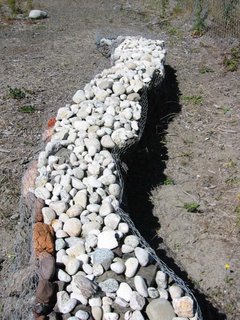Perri Lynch's FloatingDatum:FixedGrid



The beach plateau forms an arc to the west of the EPA site, a gravelly open space between trees and sea. The vortex sits farthest back from the beach and catches the wind when it blows to the West from the mouth of Eagle Harbor. Birds also nest in the gravel, and I have found a bare egg resting in a tuft of grass here.
Perri Lynch gravitated toward this site immediately, and her proposal for work reflected this connection. A grid of poles would be installed between land and water, fitted with wind indicators at the tops. As she envisioned it, "The wind indicators will pattern the directional flow and velocity of air currents. In very high winds, the piece will emit a low humming sound. The grid structure references the human compulsion to map and monitor while the sensors remind us to look and feel. This installation will create an interstitial relationship between the natural rhythms of Pritchard Park and mankind’s systematic tendencies towards land use. As a reclaimed Superfund area, I can’t imagine a more poignant place for this work."
This piece was unique to the site in its scale, its complexity of installation, and the life it took on in the larger context of the site. It was visible from a distance across the water from the ferry, from many angles of pedestrian approach, and was a piece to maneuver around and through. One of my favorite views was from the adjacent beach. From this slightly lower angle, you saw the poles rise out of the haze of blackberries and brush, capped with the flowing field of flags.
FloatingDatum:FixedGrid plays out the tension of the place on multiple levels, that theme that I found sustained throughout the vast variety of work in this show. We see deliberate human handiwork interface with the will of the wind, the imposition of industrial materials and processes on a fragile and resilient site, the calm poetry of the poles and flags as the work pins down its corner of earth. This work generates commentary and silence.
Perri's own words about her piece: "My work investigates the relationship between human perception and sense of place. Navigation, intuition, and physical proximity are key components of these investigations. I am drawn to landmarks such as billboards, survey stations, and cairns that influence our sense of direction and lead us onward. Sense of place does not exist outside of ourselves. It shifts relative to our bodies, our memories, and what we choose to pay attention to. I hope to draw attention to details in our surroundings that are often overlooked or unheard. With more sensitivity towards our environments, we all may derive a deeper sense of place.
FloatingDatum:FixedGrid examines ways in which our Cartesian sensibilities superimpose order on the world and nature’s assertion in response. The grid references mankind’s compulsion to map and monitor. Wind sensors remind us to look and feel. A regimented, axial construct is staged in forced harmony with the natural rhythms of Pritchard Park."






